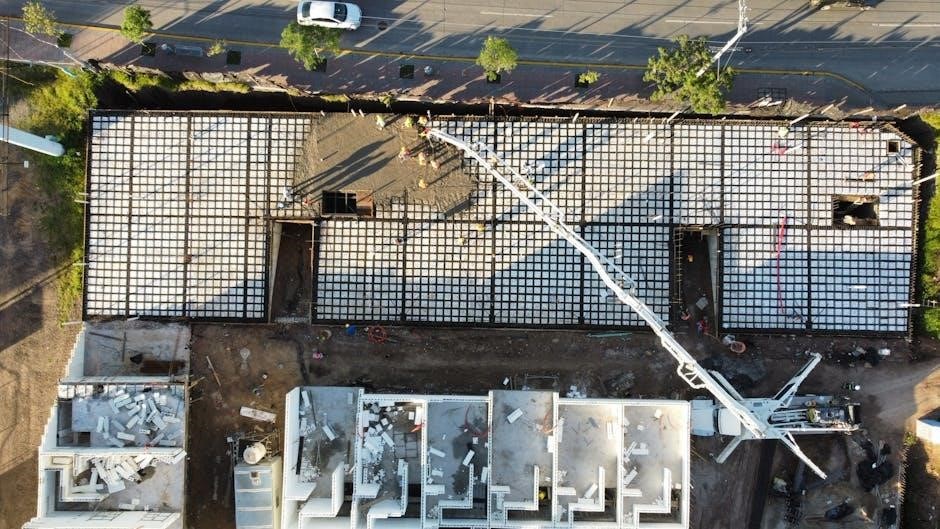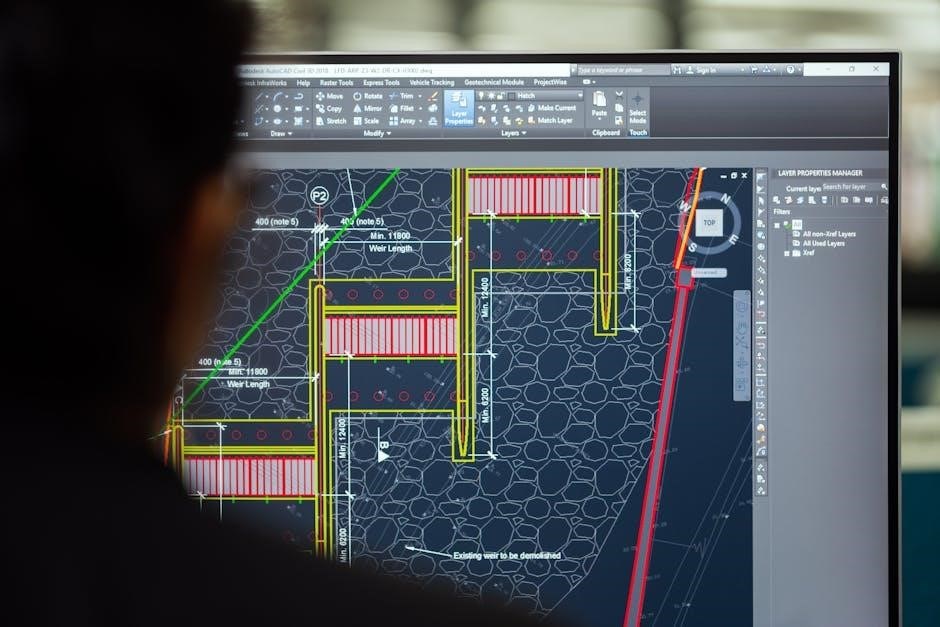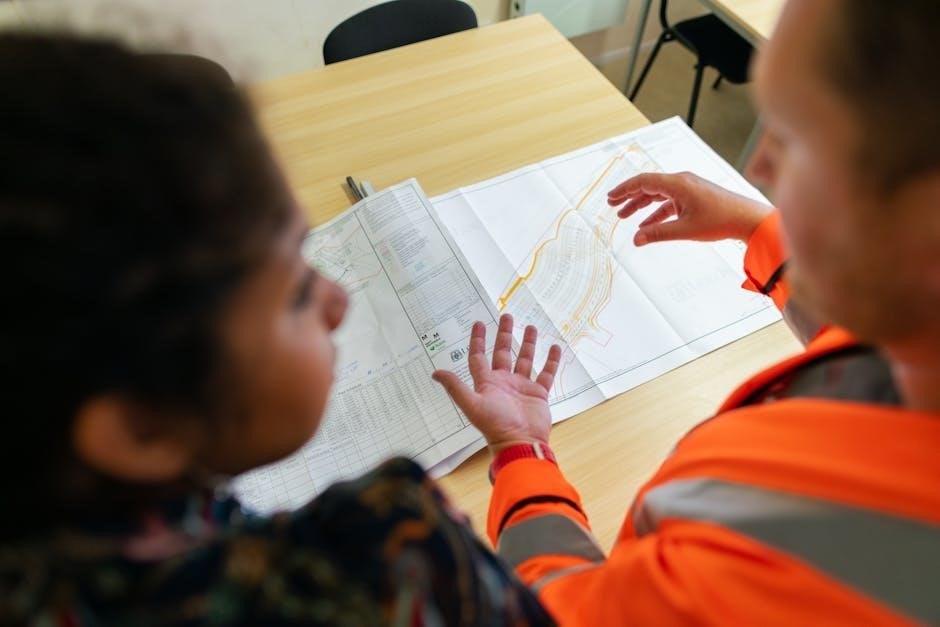Civil engineering is the art and science of designing and developing infrastructure, including roads, bridges, and buildings, to improve human life and communities. It encompasses a diverse range of specializations.
1.1 Definition and Scope
Civil engineering is the professional practice of designing, constructing, and maintaining infrastructure and public works. It involves the application of physics, mathematics, and materials science to create solutions for societal needs. The scope of civil engineering is vast, encompassing transportation systems, water supply networks, buildings, bridges, and environmental projects. It also addresses urban planning, disaster management, and sustainable development. Civil engineers work on both large-scale projects, like dams and highways, and smaller-scale projects, such as local drainage systems; The field is essential for ensuring public safety, improving quality of life, and supporting economic growth.
1.2 Importance of Civil Engineering
Civil engineering plays a vital role in shaping modern society by providing essential infrastructure. It ensures the availability of safe and reliable structures, such as roads, bridges, and buildings, which are critical for economic growth and public health. Civil engineers address challenges like water scarcity, urbanization, and climate change, ensuring sustainable development. Their work directly impacts the quality of life, enabling communities to thrive. By designing and maintaining systems for transportation, water supply, and waste management, civil engineering underpins the foundation of prosperous and resilient societies, making it indispensable to human progress and well-being.
1.3 Historical Overview
Civil engineering traces its roots to ancient civilizations, where early humans developed structures like the Pyramids, Roman aqueducts, and the Great Wall of China. The Middle Ages saw advancements in castle construction and water mills, while the Renaissance brought breakthroughs in bridge design and urban planning. The Industrial Revolution marked a turning point with the introduction of railways, canals, and steel-framed buildings. The 19th and 20th centuries saw the rise of modern infrastructure, including highways, skyscrapers, and dams. This historical progression highlights humanity’s ingenuity in shaping the built environment, laying the foundation for contemporary civil engineering practices and innovations.

Core Disciplines of Civil Engineering
Civil engineering encompasses diverse disciplines such as structural, transportation, water resources, geotechnical, and environmental engineering, each playing a vital role in building modern infrastructure and sustainable solutions.
2.1 Structural Engineering
Structural engineering is a key discipline within civil engineering, focusing on the analysis, design, and construction of structures like buildings, bridges, and towers. It ensures that structures can withstand external forces such as wind, earthquakes, and weight while remaining safe and functional. Engineers use advanced materials and principles like stress analysis and load calculations to maximize performance and durability. The goal is to create structures that are both aesthetically pleasing and structurally sound, balancing functionality with safety. Structural engineers also work on retrofitting and enhancing existing structures to meet modern standards and extend their lifespan.
2.2 Transportation Engineering
Transportation engineering focuses on designing, planning, and managing systems for the safe and efficient movement of people and goods. It encompasses roads, highways, airports, railways, and public transit systems. Engineers in this field analyze traffic flow, optimize infrastructure, and ensure compliance with safety standards. They also address environmental impacts and integrate new technologies to improve mobility. The goal is to create sustainable and accessible transportation networks that support economic growth and enhance quality of life. This discipline plays a vital role in connecting communities and fostering global connectivity.
2.3 Water Resources Engineering
Water resources engineering involves the planning, design, and management of systems for water supply, distribution, and treatment. It addresses hydrology, hydraulics, and water quality to ensure sustainable water resources. Engineers develop solutions for water storage, flood control, and irrigation while minimizing environmental impacts. This field also focuses on wastewater treatment and reuse, ensuring compliance with environmental regulations. The goal is to provide safe and reliable water systems that support communities and ecosystems. Advances in technology and sustainable practices are critical in this discipline.
2.4 Geotechnical Engineering
Geotechnical engineering focuses on the behavior of earth materials, such as soil and rock, and their interaction with structures. It involves site investigations to assess soil properties, stability, and groundwater conditions. Engineers design foundations, retaining walls, and tunnels, ensuring structural integrity and safety. This discipline also addresses slope stability, landslide prevention, and soil improvement techniques. Modern tools like geophysical surveys and computational modeling aid in precise analysis. Geotechnical engineering is crucial for preventing failures and ensuring the longevity of infrastructure projects, making it a cornerstone of civil engineering.
2.5 Environmental Engineering
Environmental engineering focuses on addressing environmental issues through sustainable solutions. It involves designing systems to improve air and water quality, manage waste, and mitigate pollution. Engineers develop technologies to treat wastewater, reduce emissions, and promote recycling. This field also addresses climate change by implementing renewable energy solutions and carbon reduction strategies. Environmental engineering ensures that infrastructure projects minimize ecological impact and promote public health. By integrating scientific principles with policy, it plays a vital role in creating a sustainable future and protecting natural resources for generations to come.

The Role of Civil Engineers
Civil engineers design, build, and maintain infrastructure, ensuring safety and sustainability. Their essential work impacts daily life and supports communities worldwide.
3.1 Responsibilities and Duties
Civil engineers are responsible for designing, planning, and supervising infrastructure projects. They conduct site inspections, ensure compliance with safety regulations, and manage construction timelines. Their duties include collaborating with architects, contractors, and government agencies to deliver functional and sustainable solutions. They also analyze data, prepare reports, and troubleshoot issues during project execution. Civil engineers must balance technical, environmental, and financial considerations to ensure projects meet societal needs while adhering to ethical and legal standards. Their role is critical in maintaining and improving the built environment for communities worldwide.
3.2 Impact on Society
Civil engineering profoundly shapes societies by creating essential infrastructure that supports daily life. From transportation systems to water supply networks, civil engineers enable economic growth, improve public health, and enhance quality of life. Their work ensures safe and reliable access to resources, fostering community connectivity and urban development. By addressing environmental challenges and developing sustainable solutions, civil engineers play a vital role in creating resilient communities. Their contributions are foundational to societal progress, ensuring that populations can thrive in a rapidly changing world. Civil engineering directly impacts human well-being and global development;
3.3 Challenges in the Field
Civil engineers face numerous challenges, including aging infrastructure, climate change, and urbanization pressures. Ensuring sustainable and resilient designs while balancing costs and environmental impact is critical. Additionally, adapting to emerging technologies and meeting societal demands for improved safety and efficiency require continuous innovation. The complexity of large-scale projects, coupled with funding constraints, further complicates the field. Civil engineers must also address public health concerns, such as water scarcity and waste management, making their role both technically demanding and socially vital. These challenges underscore the need for creativity, collaboration, and adaptability in the profession.

Education and Skills Required
A strong foundation in mathematics and physics is essential. A bachelor’s degree in civil engineering is typically required, along with skills in problem-solving, communication, and project management.
4.1 Educational Pathways
A career in civil engineering typically begins with a bachelor’s degree in civil engineering or a related field. Many universities offer accredited programs that combine theoretical knowledge with practical training. Coursework often includes mathematics, physics, chemistry, and engineering mechanics. Some students pursue master’s or doctoral degrees for advanced roles or specialization. Additionally, internships and co-op programs provide hands-on experience, preparing graduates for professional practice. Accreditation by recognized bodies ensures programs meet industry standards, equipping students with the skills needed to excel in civil engineering.
4.2 Key Skills for Success
Success in civil engineering requires a combination of technical and soft skills. Strong problem-solving and analytical abilities are essential for designing and troubleshooting structures. Effective communication skills are critical for collaboration with teams and clients. Creativity is vital for innovative solutions, while attention to detail ensures safety and compliance with standards. Proficiency in engineering software, such as CAD and project management tools, is increasingly important. Additionally, leadership and teamwork skills are necessary for managing projects and motivating colleagues. Adaptability and a commitment to lifelong learning are crucial in this ever-evolving field.
4.3 Professional Certifications
Professional certifications are crucial for advancing a career in civil engineering. Obtaining a Professional Engineer (PE) license is a key milestone, demonstrating expertise and commitment to ethical practice. Certifications like LEED Accredited Professional (AP) for sustainable design and Project Management Professional (PMP) for project leadership can enhance career prospects. Specialized certifications in areas such as structural engineering or water resources further validate skills. These credentials often require a combination of education, experience, and passing rigorous exams; They not only boost earning potential but also signify a higher level of competence and dedication to the field.
Civil Engineering Design and Construction

Civil engineering design and construction involve creating detailed plans and executing them efficiently, ensuring safety, functionality, and sustainability. Skilled professionals utilize advanced tools and methods to deliver successful projects.
5.1 Design Process
The civil engineering design process begins with defining project requirements and conducting site analyses. Engineers develop conceptual designs, followed by detailed plans and simulations; They ensure compliance with regulations and standards. Collaboration with stakeholders is crucial to refine ideas. Final designs incorporate safety, functionality, and sustainability principles. The process transitions seamlessly into construction, ensuring practical implementation. Effective communication and iterative revisions are key to achieving optimal solutions. This systematic approach guarantees that projects meet specified goals and withstand environmental and structural challenges over time.
5.2 Construction Techniques
Civil engineering construction techniques encompass a variety of methods to build infrastructure. These include foundation work, concrete placement, steel construction, and earthmoving. Modern techniques utilize advanced materials like high-strength concrete and steel composites. Precast and prefabricated components are increasingly used for efficiency. Construction equipment, such as cranes, excavators, and pavers, streamlines the process. Safety protocols and quality control measures ensure durability and compliance. Sustainable practices, like using recycled materials, are integrated to minimize environmental impact. The combination of traditional methods and innovative technologies ensures projects are completed efficiently and safely, meeting current and future demands.
5.3 Project Management
Project management in civil engineering involves planning, coordinating, and controlling resources to achieve project goals. It includes scheduling, budgeting, and risk management. Effective communication and stakeholder engagement are critical. Civil engineers use tools like Gantt charts, project management software, and Building Information Modeling (BIM) to streamline processes. Ensuring compliance with safety standards and environmental regulations is essential. Successful project management balances time, cost, and quality while addressing potential delays or overruns. It requires strong leadership, problem-solving skills, and adaptability to deliver projects efficiently and meet client expectations.

Materials and Technologies
Civil engineering relies on a wide range of materials, from traditional concrete and steel to advanced composites. Modern technologies like BIM and 3D printing enhance design and construction efficiency.
6.1 Traditional Materials
Traditional materials in civil engineering include concrete, steel, wood, and masonry. Concrete, a composite of cement, water, and aggregates, is renowned for its strength and versatility. Steel is prized for its high tensile strength and flexibility, making it ideal for frameworks and reinforcement. Wood, a renewable resource, is used for structural elements and finishes due to its lightweight and aesthetic appeal. Masonry, involving bricks, mortar, and stone, offers durability and thermal mass. These materials have been the backbone of infrastructure development for centuries, enabling the construction of buildings, bridges, and roads. Their reliability and cost-effectiveness ensure continued use alongside modern alternatives.
6.2 Advanced Materials
Advanced materials in civil engineering include fiber-reinforced polymers, self-healing concrete, and high-strength steel. Fiber-reinforced polymers offer exceptional durability and resistance to corrosion, ideal for structural reinforcement. Self-healing concrete incorporates bacteria that produce calcite, reducing cracks and extending lifespan. High-strength steel enables lighter and stronger structures, optimizing resource use. These materials address modern challenges like sustainability and durability, enhancing performance and reducing maintenance. Their adoption is transforming construction, enabling innovative designs and improving infrastructure resilience. Advanced materials are pivotal in meeting the demands of contemporary and future civil engineering projects, ensuring efficiency and longevity.
6.3 Role of Technology
Technology plays a pivotal role in modern civil engineering, revolutionizing design, construction, and project management. Tools like BIM (Building Information Modeling) and CAD (Computer-Aided Design) enable precise planning and collaboration. Advanced software streamlines structural analysis and simulation, ensuring safety and efficiency. Automation and robotics optimize construction processes, reducing errors and labor costs. IoT devices and sensors monitor infrastructure health, enabling predictive maintenance. Drones and 3D printing are transforming site surveys and material application. These technologies enhance sustainability, reduce timelines, and improve resource utilization, driving innovation and modernization in the civil engineering sector.
Sustainability in Civil Engineering
Sustainability in civil engineering focuses on creating eco-friendly infrastructure that minimizes environmental impact while meeting societal needs. It emphasizes energy efficiency, renewable resources, and waste reduction to ensure long-term environmental health.
7.1 Green Infrastructure
Green infrastructure integrates natural or semi-natural systems into urban planning to manage environmental challenges. Techniques include green roofs, rain gardens, and permeable pavements, which enhance stormwater management and reduce runoff. These solutions improve air quality, mitigate urban heat islands, and support biodiversity. By incorporating vegetation and sustainable materials, green infrastructure promotes ecological balance and resilience. It aligns with sustainable development goals, offering both environmental and economic benefits while enhancing community well-being. Green infrastructure is a vital component of modern civil engineering, addressing climate change and urbanization effectively.

7.2 Environmental Impact
Civil engineering projects can significantly impact the environment, often causing resource depletion, habitat disruption, and pollution. Construction activities contribute to deforestation, water contamination, and carbon emissions. However, sustainable practices aim to minimize these effects. Environmental assessments and mitigation strategies are essential to balance development with ecological preservation. Civil engineers play a crucial role in designing projects that reduce environmental harm while meeting societal needs. By adopting eco-friendly technologies and materials, the field strives to lower its ecological footprint and promote long-term environmental health.
7;3 Future Trends
The future of civil engineering lies in sustainability, innovation, and resilience. Trends include the integration of green technologies, renewable energy systems, and smart infrastructure. Building Information Modeling (BIM) and AI will enhance design and project management. Autonomous construction equipment and 3D printing are revolutionizing construction processes. There is also a growing focus on climate resilience and adaptive structures. Modular and prefabricated construction are gaining popularity for speed and efficiency. These trends aim to address global challenges like urbanization, resource scarcity, and climate change, ensuring civil engineering continues to shape a sustainable and connected world.

Codes and Standards
Civil engineering relies on codes and standards to ensure safety, durability, and consistency in construction. These guidelines, developed by organizations like ACI and ASCE, regulate materials, design, and practices.
8.1 Importance of Codes
Civil engineering codes are essential for ensuring safety, reliability, and consistency in construction projects. They provide standardized guidelines for design, materials, and practices, minimizing risks and failures. Codes are developed by expert organizations and regularly updated to reflect advancements in technology and research. Compliance with these codes ensures legal adherence, public safety, and infrastructure durability. They also facilitate uniformity across projects, making it easier to compare and evaluate designs globally. By following codes, engineers can avoid costly errors and ensure that structures meet societal needs while protecting the environment. Codes are the backbone of ethical and sustainable engineering practices.
8.2 International Standards

International standards in civil engineering ensure consistency and safety across borders by providing uniform guidelines for materials, designs, and construction practices. Organizations like ISO develop these standards to facilitate global collaboration and trade. They cover aspects such as material testing, structural design, and sustainability practices. By adhering to international standards, engineers can ensure that projects meet universal safety and quality expectations. These standards also promote innovation and efficiency, as they are often based on the latest research and best practices. They play a crucial role in addressing global challenges like climate change and resource management, ensuring sustainable development worldwide.
8.3 Compliance and Safety
Compliance with safety regulations is paramount in civil engineering to protect people, infrastructure, and the environment. Safety protocols ensure that construction sites and completed structures meet legal and ethical standards. Engineers must conduct risk assessments, implement protective measures, and adhere to building codes to prevent accidents and failures. Regular inspections and audits are essential to maintain compliance and safety throughout project lifecycles. Non-compliance can lead to legal penalties, environmental damage, and loss of life. Thus, prioritizing safety and compliance is critical for sustainable and responsible engineering practices that benefit society and future generations.
Notable Civil Engineering Projects
From ancient marvels like the Great Wall of China to modern feats like the Burj Khalifa and Panama Canal, these projects showcase engineering’s transformative impact on society.
9.1 Iconic Structures
Iconic structures like the Great Wall of China, Eiffel Tower, and Burj Khalifa exemplify human ingenuity and engineering excellence. These landmarks, often serving as national symbols, showcase advanced techniques and historical significance. The Great Wall, constructed over centuries, highlights ancient engineering prowess, while the Eiffel Tower revolutionized iron lattice designs. Modern marvels such as the Burj Khalifa demonstrate cutting-edge innovations in skyscraper construction; These structures not only inspire awe but also reflect the evolution of civil engineering, blending functionality with artistic expression to create lasting legacies that influence future architectural and engineering advancements.
9.2 Mega Infrastructure Projects
Mega infrastructure projects are large-scale undertakings that transform societies and economies. Examples include the Hoover Dam, Channel Tunnel, and Interstate Highway System. These projects often involve significant engineering challenges, such as complex logistics and environmental considerations. They play a crucial role in connecting regions, enhancing transportation, and providing essential services. The scale and impact of these projects highlight the importance of meticulous planning and collaboration among experts. Mega infrastructure initiatives not only address current needs but also shape the future of urban and regional development, leaving a lasting legacy for generations to come.
9.3 Innovations in Design
Modern civil engineering has embraced innovative design approaches to create sustainable and efficient structures. Parametric design enables complex geometries, while modular construction streamlines processes. Building Information Modelling (BIM) enhances precision and collaboration. Adaptive structures, capable of changing shape in response to conditions, represent a cutting-edge advancement. Innovations like 3D printing and self-healing materials are transforming construction. These designs not only improve functionality but also reduce environmental impact. Such advancements ensure civil engineering continues to meet the demands of a rapidly evolving world, blending creativity with technical excellence to create smarter, resilient infrastructure.

The Future of Civil Engineering
The future of civil engineering lies in sustainable practices, smart materials, renewable energy integration, and advanced technologies to address global infrastructure challenges and promote eco-friendly development effectively.
10.1 Emerging Trends
Emerging trends in civil engineering include the integration of smart technologies, sustainable practices, and renewable energy sources. The use of AI and machine learning is optimizing design and construction processes. Modular and prefabricated construction is gaining popularity, reducing costs and timelines. Green building materials and energy-efficient systems are becoming standard. Resilience and adaptability in infrastructure design are critical to address climate change. Autonomous vehicles and hyperloop systems are reshaping transportation engineering. These trends are driving innovation and transforming the industry to meet future demands sustainably and efficiently.
10.2 Technological Advancements
Technological advancements are revolutionizing civil engineering, with tools like Building Information Modelling (BIM) enhancing project planning and execution. 3D printing is enabling rapid construction of complex structures. Drones are being utilized for site inspections and surveying, improving accuracy and safety. Advanced materials like self-healing concrete and high-performance steel are reducing maintenance needs. IoT and smart sensors monitor infrastructure health in real time. These technologies are streamlining processes, reducing costs, and enabling the creation of sustainable and resilient infrastructure for future generations.
10.3 Global Challenges
Civil engineering faces global challenges, including climate change, urbanization, and resource scarcity. Rising temperatures and extreme weather threaten infrastructure durability. Rapid urbanization demands sustainable solutions to housing and transportation. Water scarcity and pollution require innovative water management systems. Additionally, the industry must address the shortage of skilled labor and funding constraints. Meeting these challenges requires collaborative efforts, technological innovation, and sustainable practices to ensure resilient infrastructure for future generations while minimizing environmental impact.
Civil engineering plays a vital role in shaping modern society by creating infrastructure that supports daily life. From designing buildings to managing water resources, civil engineers address complex challenges to ensure safety and sustainability. The field continually evolves, embracing new technologies and sustainable practices to meet global demands. As populations grow and environmental concerns intensify, the importance of civil engineering grows. By fostering innovation and collaboration, civil engineers will continue to build resilient communities and improve the quality of life for future generations.




Leave a Reply
You must be logged in to post a comment.